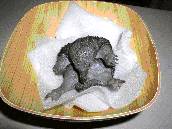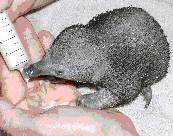RAISING ECHIDNAS
Click on photos for larger pics .It will open in a new window - close that window to return here
 FEEDING AT THE UNSPINED STAGE:
FEEDING AT THE UNSPINED STAGE:
It is a little difficult to tube feed an echidna at first, but once you have executed it a few
times, it will get easier, and it will not be long before you will master the technique.
WEIGH-IN:
Weigh the puggle on a set of digital scales prior to feeding so that an estimation of how much to
feed can be determined.

TWENTY PERCENT OF BODYWEIGHT:
If the puggle weighs 100 gram divide that by 10 which equals 10, then double that for 20% of the
body weight. So you will need to feed 20ml. The reason why 20% is used is that you do not want to
feed too less an amount resulting in the puggle actually losing more weight in between the feed
times, than what it weighed before this feed time.

FEEDING TECHNIQUE:
Offer the milk in the palm of your hand first, ensuring the milk is only tepid in temperature
This can be done by squirting a little at a time from a plastic syringe. If the puggle slurps
formula.
Continue squirting into your hand until it has had enough. This could take a while (up to an hour)
as they take approximately 4 hours to drink from their mother at one feed time.
Once the puggle
stops showing an interest in slurping pop it back on the scales.
Whatever it weighs, take that
weight away from the initial weight and work out how many ml it has slurped.
1ml equals 1 gram.
You will have to tube feed the remainder to make up the 20%.

TUBE FEEDING TECHNIQUE:
You will need a 60ml plastic syringe, a 5 gauge gastric feeding tube, KY jelly, and a jug of warm
water.
Draw up the amount required plus an extra couple of mls into the syringe. Attach the tube
to the syringe. Place the syringe and empty tube into the warm water. To check the temperature,
pull back and allow air into the syringe and shake. Then push the plunger so that the milk comes
out of the tube and try the temperature by squirting milk onto your wrist.
If the milk is not
warm
 or cold it will be the correct temperature.
or cold it will be the correct temperature.
Now lubricate the tube with the KY jelly to ensure a
smooth insertion down the oesophagus. The tube will be filled with milk so as air does not go into
the stomach.
To open the puggle’s mouth, place your thumb and forefinger down each side of the mouth and push
them towards each other, be firm but gentle.
Immediately the mouth opens just a little, push the
tube down. Initially the insertion will go fairly easily, as the little puggle at this stage is
unaware of how to prevent the tube going down.
If the insertion stops long before the black texta
mark pull it out a little and push it down again, as it may have gone into the lung. Usually the
tube goes down smoothly and easily.
There is no chance of the tube ending up in the lung if it
goes down to the texta mark. Once at the mark gradually push the plunger. Sometimes it is very
hard to push the plunger and it is easier to have someone else doing the pushing, but if on
your own, press the plunger against your chest bone, pushing the syringe with your chest.
You other hand has to keep the tube in the mouth and keep the mouth closed.
The little puggle will just sit/stand there without struggling.
I have even been able to tube feed without holding the puggle’s mouth, while it just wobbled
around!
This of course is not possible once the puggle is older and has an idea of pushing the tube out
with its throat and tongue muscles! You should be finished pushing the milk through within about
5 minutes.
Take care to keep the bottom of the syringe where the tube connects BELOW the top of
the syringe where the plunger is, to ensure no air goes into the gut. Angle the syringe to ensure
this.
Once all of the milk (except the amount in the tube) is all gone, pull the tube out and place the
tube and the syringe directly into hot water. If you squirt some hot water immediately through
the tube it will make it easier to prevent the milk from sticking inside.
Copyright © 2003 Lynda Staker -
Taken from Lynda Staker's book " Don't Step Backwards "
Back to Echidna index
Back to FRW Home page
 FEEDING AT THE UNSPINED STAGE:
FEEDING AT THE UNSPINED STAGE:


 or cold it will be the correct temperature.
or cold it will be the correct temperature.